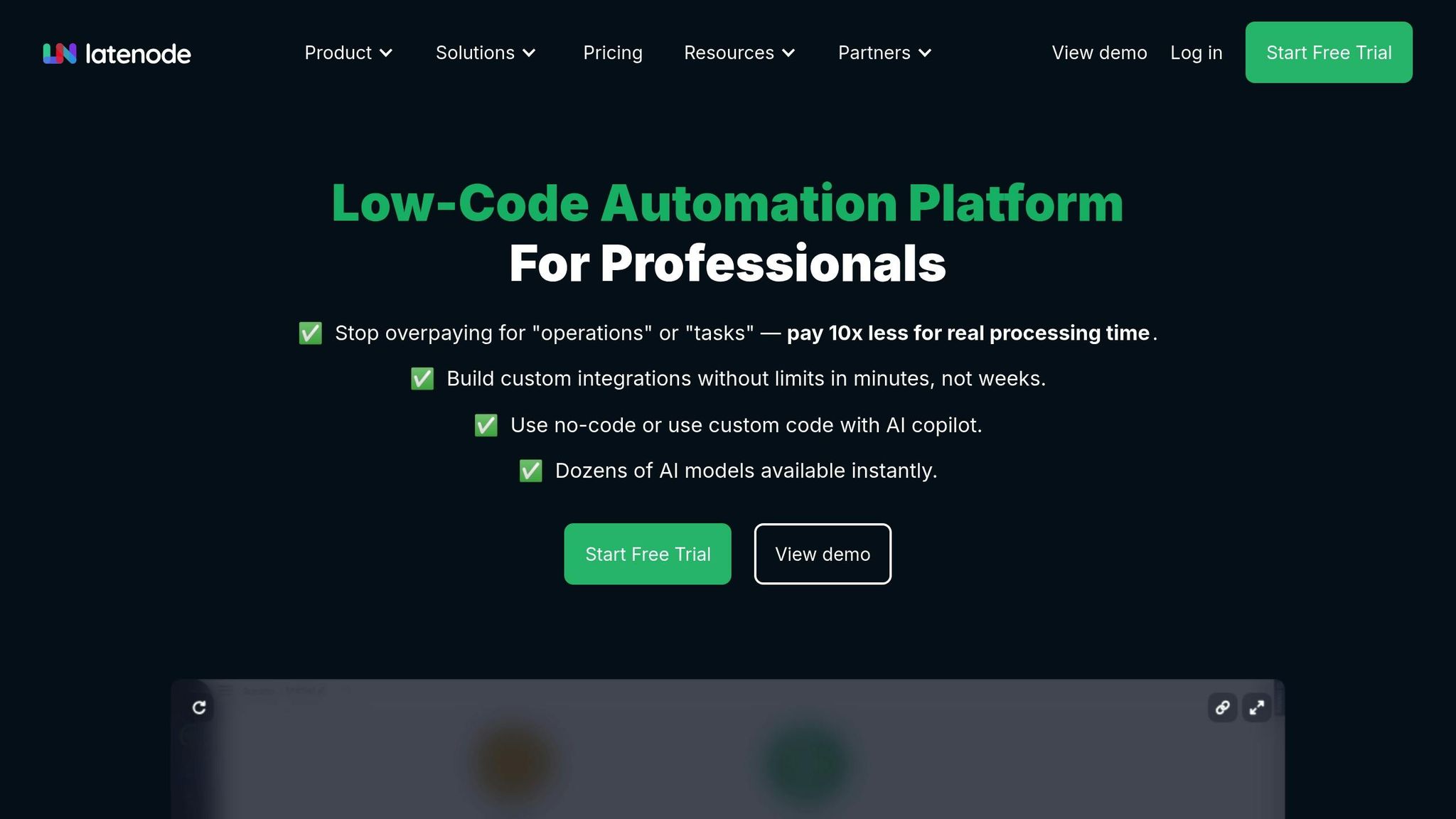


AI agents don’t just follow rules - they learn, adapt, and act autonomously.
This guide explains how businesses can use AI agents to automate workflows, improve accuracy, and save time without writing code. From streamlining customer support to optimizing marketing, you’ll learn how to:
Platforms like Latenode make it easy to design and deploy these workflows visually, connecting apps and AI in a low-code environment.
Let’s dive into how you can build smarter, automated systems.
Create effective AI workflows by breaking tasks into smaller parts and ensuring smooth integration with existing systems.
To design efficient workflows for AI agents, it’s important to divide complex processes into smaller, actionable steps. Take customer support ticket processing as an example. A well-structured workflow might include:
Think of an AI agent as a virtual assistant that doesn’t just answer questions but also takes action - like reading emails, querying a CRM, and drafting responses on its own [3].
Once tasks are broken down, AI can apply language processing techniques to automate them further.
AI agents rely on Natural Language Processing (NLP) to understand context and perform tasks accurately. These systems handle both structured data (like spreadsheets) and unstructured data (like emails or chat messages). They adapt to specific needs through prompting, manage multi-step processes, and improve over time by learning from feedback.
For example, in digital marketing, an AI-powered YouTube Trend Finder can analyze video performance, identify trending topics such as "psychological marketing", and recommend relevant tags like "SEO" or "Conversion Rates" to help optimize content strategies [2].
Integrating AI agents with business tools is essential to maximize their potential. Focus on these three key areas for successful integration:
It’s also important to design workflows that are modular and scalable. This approach makes it easier to update and maintain systems while supporting long-term business growth. As your automation needs grow, you can expand operations step by step without needing to rebuild the entire setup.
AI agents are reshaping business operations by automating repetitive tasks and improving productivity across various departments. Here’s how they’re making an impact on everyday workflows.
In modern workplaces, AI agents simplify administrative tasks, minimizing the need for manual effort and reducing errors. These tools can handle a range of activities, from data entry to scheduling, freeing up employees to focus on higher-value work.
For example, an AI agent can efficiently manage interview scheduling by scanning calendars, sending personalized invitations, handling confirmations or reschedules, and issuing timely reminders. Similarly, HR departments benefit from automation in processes like onboarding, where agents create credentials and organize documents seamlessly.
"AI agents are transforming industries, automating and enhancing processes leading to increased efficiency, accuracy and decision-making ability." - Onome, Contributor & AI Expert [4]
By streamlining these processes, businesses can shift their focus to automation in more strategic areas like marketing.
Marketing teams use AI agents to optimize campaign management and content creation, enabling them to concentrate on strategic planning while ensuring smooth execution.
With tools like Latenode, marketing teams can automate various aspects of their workflows, such as:
This level of automation also extends to lead engagement. AI agents can handle initial contact, manage nurturing sequences, and ensure communications are timely and personalized. These capabilities demonstrate the advantages of integrating AI into marketing, where efficiency and consistency are paramount.
For more complex business processes, multiple AI agents often work collaboratively, each focusing on a specific role. A consulting firm showcased this approach by implementing the following [5]:
"The core concept of this system is separating 'thinking' from 'execution'." - James Li, Senior LLM Engineer [5]
In customer service, for instance, AI agents can respond instantly to inquiries, escalate complicated issues when needed, and significantly cut down response times. This improves customer satisfaction while ensuring operational efficiency. By clearly defining each agent’s role and maintaining smooth communication between them, businesses can create cohesive systems that deliver measurable results. Together, these agents demonstrate the power of coordinated AI deployment in enhancing both speed and accuracy.

AI agents are reshaping how businesses operate. Here’s how you can implement them using Latenode’s low-code platform.
Latenode’s visual builder allows you to design workflows by simply dragging and dropping elements. This makes automating even complex tasks straightforward, as the workflows align with your business processes.
"I honestly love how Latenode has approached automation. The 'low-code' approach is perfect for my needs. I'm not a developer, but with the help of their AI helper I can get cool stuff done very quickly!" - Stockton F. [6]
Here’s how workflows come together:
"AI Nodes are amazing. You can use it without having API keys, it uses Latenode credit to call the AI models which makes it super easy to use." - Islam B. [6]
If standard nodes don’t meet your needs, Latenode’s AI Code Copilot can generate custom scripts, blending the simplicity of no-code tools with the flexibility of custom development.
"The AI JavaScript code generator node is a life saver. If you get to a point in the automation where a tool or node isn’t yet created to interact with Latenode, the AI..." - Francisco de Paula S., Web Developer Market Research [6]
This feature supports:
Latenode simplifies linking different apps into unified workflows. It offers pre-built nodes for a wide range of popular SaaS tools.
"Latenode is a cheaper but powerful alternative to the usual AI automation tools. It's easy to use, even for beginners, thanks to its simple and intuitive interface." - Sophia E. [6]
To set up integrations:
With support for over 1,000 apps, Latenode provides a centralized way to manage your automation efforts, helping your workflows grow alongside your business.
Implementing AI agents effectively requires careful monitoring, thoughtful alignment with business goals, and seamless coordination. Use these practical tips to refine your workflows and achieve better results.
Keeping an eye on performance metrics is essential to ensure your AI agents operate efficiently. Focus on these three categories:
| Metric Category | What to Track | How to Optimize |
|---|---|---|
| Task Speed | Completion times, response delays | Use distributed processing; minimize bottlenecks |
| Decision Accuracy | Output quality, error rates | Refine AI models; improve training datasets |
| Resource Usage | System utilization, costs | Balance workloads; fine-tune resource allocation |
Latenode's analytics dashboard can help you monitor these metrics and spot areas for improvement. Tailor the metrics to match your business goals for more meaningful insights and results.
To ensure your automation efforts deliver value, align them with your organization's specific objectives. Here’s how to do it:
By following these principles, you can create a solid foundation for managing and scaling your automation strategy.
Handling multiple AI agents can be challenging, but with proper organization, it becomes manageable. Here are some strategies to streamline multi-agent systems:
"AI agents are transforming industries, automating and enhancing processes leading to increased efficiency, accuracy and decision-making ability." - Onome, Contributor & AI Expert [4]
AI agents have transformed how businesses approach automation, driving efficiency and productivity to new levels. With proper planning and practical application, companies can simplify operations while managing complex workflows effectively. Platforms like Latenode strike a balance between advanced functionality and user-friendly design, offering AI-driven automation alongside options for custom coding to meet diverse technical needs.
The benefits of well-executed AI automation are evident in real-world applications. Mike Kirshtein, Founder & Leadership at Audax Group, shares his experience:
"Latenode has replaced Zapier and Make⚡️ Our business requires us to send lots of webhooks every day and we need a reliable service that's easy on the pockets and that's Latenode." [6]
To fully leverage the potential of AI agents, focus on the following principles:
When these practices are paired with regular evaluation and adjustments, they lay the groundwork for sustained improvements in operational efficiency. Whether you're automating repetitive tasks or managing intricate processes, AI agents offer a pathway to smarter, more adaptable business solutions. By applying these strategies, you can build automation systems that deliver meaningful results while remaining flexible for future advancements.
AI agents can significantly enhance customer support by simplifying and automating key tasks, even for those with minimal coding experience. Using low-code platforms and AI tools, you can create custom chatbots to handle help desk queries, resolve common issues, and provide real-time assistance to customers. These solutions are designed to be user-friendly, enabling businesses to deploy AI-powered support quickly and efficiently.
For example, AI assistants can help with automating routine responses, analyzing customer inquiries, and even providing suggestions for resolving complex issues. By integrating AI into your support workflows, you can save time, reduce manual effort, and improve the overall customer experience - all without needing extensive technical expertise.
When integrating AI agents into your business tools and workflows, it's important to focus on how they can streamline repetitive tasks and enhance overall efficiency. Consider how AI can automate processes in areas like marketing, customer support, or data analysis, ensuring these solutions align with your specific business goals.
Additionally, evaluate the compatibility of the AI agent with your existing platforms and tools. Look for options that support low-code or no-code integration, making it easier to implement without extensive technical expertise. Prioritize solutions that offer flexibility and scalability to grow with your business needs.
Lastly, ensure the AI agent is user-friendly and capable of delivering actionable insights to help your team make informed decisions. A well-integrated AI system should save time, reduce errors, and drive measurable results tailored to your workflows.
To ensure AI workflows stay flexible and scalable, businesses should focus on modularity, scalability, and error handling. Modularity allows you to update or replace individual components without disrupting the entire system. Scalability ensures workflows can handle increased demand as your business grows, while robust error handling prevents minor issues from turning into major disruptions.
Additionally, implementing distributed processing and load balancing can help avoid bottlenecks and maintain smooth operations as workflows expand. By designing workflows with these principles in mind, you can future-proof your processes and adapt to evolving needs with ease.



